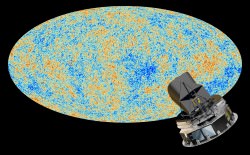Since telescopes let us look back in time, shouldn’t we be able to see all the way back to the very beginning of time itself? To the moment of the Big Bang?
You’ve probably heard that looking out into space is like looking back in time. As it takes light 1 second to get from the Moon to us. Whenever we view it, we’re seeing it 1 second in the past. The Sun is 8 light minutes away, and the light we see from it is from 8 minutes into the past.
A better example might be Andromeda, it’s 2.5 million light years away… and you guessed it, we’re seeing it 2.5 million years in the past. Since the Big Bang happened 13.7 billion years ago, using this idea, shouldn’t we be able look all the way back to the beginning of time, even if we’ve misplaced the key to our Tardis?
At the very beginning of the Universe, seconds after the Big Bang, everything was mushed together. Energy and matter were the same thing. Dogs and cats lived together. There was no difference between light and radiation, it was all just one united force.
You couldn’t see it, because light didn’t actually exist. There were no such thing as photons.
However, if you’re still insisting there’s no such thing as photons, you might want to check yourself. After these things started to separate. Photons and particles became actual things. Electromagnetism and the weak nuclear force split off and formed new bands, but could never quite get the momentum of the original lineup.
By the end of the first second, neutrons and protons were around, and they were getting mashed by the intense heat and pressure into the first elements. But you still couldn’t see that because the whole Universe was like the inside of a star. Everything was opaque. It was Scarlett Johansson hot, and too crazy to form stable atoms with electrons as we see today.

After the Universe was about 380,000 years old, it had cooled down to the point that proper atoms could form. This is the moment when light could finally move, and travel distances across the Universe to you and get caught up in your light buckets. In fact, this light is known as the cosmic microwave background radiation.
So, how come we don’t see all this freed light in all directions with our eyes? It’s because the region of space where it exists is so far away, and travelling away from us so quickly. The light’s wavelengths have been stretched out to the point that light has been turned into microwaves. It’s only with sensitive radio telescopes and space missions that astronomers can even detect it.
Unfortunately, we’ll never be able to see the Big Bang. Even though we’re looking back in time, right to the edge of the observable Universe, it’s just beyond our reach. If you could look at the Universe at any point in time, what would it be? Tell us in the comments below.
And if you like what you see, come check out our Patreon page and find out how you can get these videos early while helping us bring you more great content!


I’ve always wondered in which direction of space would we look to “see” the Big Bang (with Earth being the point of observation).
That’s a great question and the short answers is that the universe comes to an infinitesimally small dimensionless point in every direction you are looking. This is because you are not only seeing deep into space, but also back in time – back to the Big Bang event.
Every point within the universe shares a common frame of reference of observing itself to be the oldest, most central and most distant point from the BB event as any other point within the entire singularity. Even though new time and space is continuously unfolding within our universe, it still maintains characteristics of the singularity of our origin.
The origin point of the singularity (the BB event when time started unfolding) is about 47.5 billion light years away in every direction in our 13.8 billion year-old universe. This counter-intuitive observation is due to the fact that new time and space is continuously being created within the singularity everywhere at once. The origin point of the universe has receded beyond our observable horizon; and note that every other point in the universe shares this same observed reference frame.